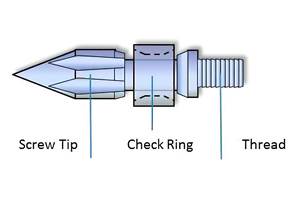Mold Micro Parts Just One Pellet at a Time
Here is a closer look at the unusual micro-injection molding press that was reported briefly in our October issue.
Here is a closer look at the unusual micro-injection molding press that was reported briefly in our October issue. Because it molds parts the size of sesame seeds, the manufacturer has dubbed it the Sesame series. It is the first venture into plastics molding machinery from Murray, Inc. (also known as Medical Murray Inc.), Buffalo Grove, Ill. Murray is a consulting engineering firm that designs medical parts and custom-builds special machinery to produce them. It had built molds for micro-sized plastic parts but found no suitable machine for molding them. So it built its own.
The Sesame machine is designed for precision molding of parts from 0.0004 to 0.40 sq in. area and weighing as little as 0.0001 g, says Brent Roland, director of sales and marketing. Parts can have walls as thin as 0.001 in. The firm offers two models for thermoplastic molding and one for liquid silicone rubber (LSR). Each model comes in two shot-size ranges.
Thermoplastic models come with 0.4- or 1.7-ton clamp force and shot capacities ranging from about 0.082 g to 0.580 g. The LSR press has a 0.4-ton clamp (1.7 tons optional) and shot capacity of about 0.22 or 0.75 g. Injection-pressure ranges from about 29,700 to 50,800 psi for thermoplastics and 21,000 psi for LSR. All units offer injection speeds up to 1250 mm/sec, clamp daylight of 232 mm, minimum mold height of 82.5 mm, and clamp stroke of 150 mm. The machine handles a maximum mold size of 90 x 95 mm. Overall machine size is 24 x 54 in. x 64 in. high.
Designed for clean-room use, the machines are built of stainless steel and anodized aluminum. They use no lubricant or hydraulic oil. They operate on 120V AC current and 90-psi shop air. Roland says the machines can mold any thermoplastic, including LCPs. Nominal base price is $60,000.
One pellet at a time
Figure 1 shows the Sesame injection mechanism. A stepper motor drives the pellet feeder to deliver as little as one pellet for each plasticating cycle in order to minimize residence time and chances of material degradation. Instead of a screw—which would hold too much material—the press has a heated plasticating cylinder with a plunger. The resin melts in the hot cylinder, and then the air-driven plunger (10 mm diam.) pushes the material into the injection chamber. There, a linear servo motor drives a needle-thin (1 to 3.5 mm) injection plunger. A high-pressure valve separates the plastication and injection sections, and a shut-off nozzle prevents drool. Controls provide two steps of injection speed and holding pressure. Operator interface is a color touchscreen PC.
The LSR (or LIM) models feed two-component silicone materials from 50-cc cartridges. Features include integral fluid cooling of the shut-off nozzle and two-zone electrical mold heating. The Sesame machine can be switched from thermoplastic to LIM molding in 20 min.
Figure 2 shows the clamping mechanism, which is driven by dual self-aligning pneumatic cylinders. Molded parts are removed with air-driven ejector pins and core pulls. Murray designed a parts-handling system for one customer in which vacuum tubes suck parts out of the mold and transport them to a container.
At least three machines have been sold since 1998 for applications like molding tips or fittings onto catheter tubes, in-line plastic/metal assembly, and electronic component manufacturing.
Related Content
Got Streaks or Black Specs? Here’s How to Find and Fix Them
Determining the source of streaking or contamination in your molded parts is a critical step in perfecting your purging procedures ultimately saving you time and money.
Read MoreA Systematic Approach to Process Development
The path to a no-baby-sitting injection molding process is paved with data and can be found by following certain steps.
Read MoreInjection Molding: Focus on these Seven Areas to Set a Preventive Maintenance Schedule
Performing fundamental maintenance inspections frequently assures press longevity and process stability. Here’s a checklist to help you stay on top of seven key systems.
Read MoreWhat to Look for in High-Speed Automation for Pipette Production
Automation is a must-have for molders of pipettes. Make sure your supplier provides assurances of throughput and output, manpower utilization, floor space consumption and payback period.
Read MoreRead Next
For PLASTICS' CEO Seaholm, NPE to Shine Light on Sustainability Successes
With advocacy, communication and sustainability as three main pillars, Seaholm leads a trade association to NPE that ‘is more active today than we have ever been.’
Read MoreSee Recyclers Close the Loop on Trade Show Production Scrap at NPE2024
A collaboration between show organizer PLASTICS, recycler CPR and size reduction experts WEIMA and Conair recovered and recycled all production scrap at NPE2024.
Read More










